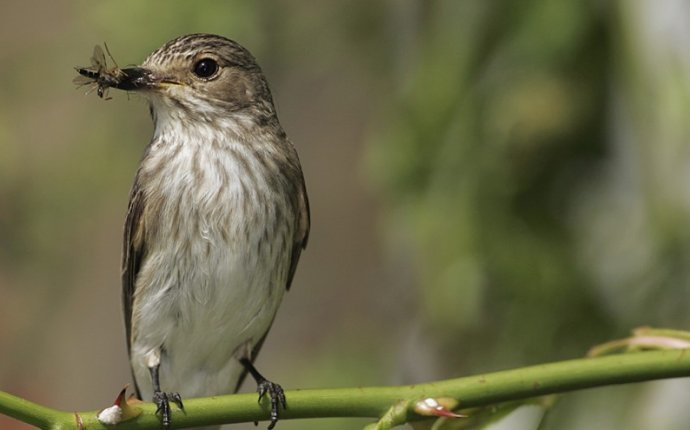
Flycatcher Bird Pictures
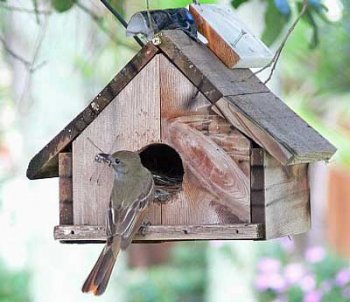
The photos of this Great Crested Flycatcher (GCFL) family (except for the eggs) are by Richard Hodder and Betsy Marie of Orlando, FL. This shot was taken with a Luminex Z30.
This female (named Audrey) has returned to this box for four years in a row, raising a brood of five each time.
Photo by Richard Harlow of Milton, VT. This nest was just a mass of material. Not all messy nests are from rodents!The flycatcher nested in the back right corner completely covered with debris.
Great Crested Flycatcher eggs. Photo by Keith Kridler of TX. Notice snake skin and cellophane. Eggs usually hatch over a 1-2 day period. The white and brown egg in center is from a Cowbird.
Nest Description: Bulky nest constructed of twigs, leaf litter, pine needles, bark, moss, lichen, grass, and rootlets, usually about 10-18" high (most are 12-15"). Off to one side a cup is lined with finer hair, feathers or fur. A piece of snakeskin or cellophane is often found in the nest.
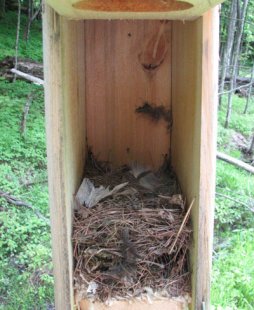 Eggs (larger than a HOSP egg), moderately glossy, ivory/cream/pink, and densely streaked/scrawled with fine purple, gray, red, brown, or olive markings often concentrated on the larger end of the egg.
Eggs (larger than a HOSP egg), moderately glossy, ivory/cream/pink, and densely streaked/scrawled with fine purple, gray, red, brown, or olive markings often concentrated on the larger end of the egg.
"Audrey's" babies. Photo by Betsy Marie.
There are actually five nestlings in the box. When the camera came close, they all huddled down and flattened out.
GCFL incubation lasts 13-15 days, starting when the next to last egg is laid.
These nestlings are 16 days old. This was the day they fledged. Photo by Betsy Marie.
GCFLs usually fledge 14-21 days (13-15 may be typical) after hatching. They may stay in the nest longer when food is limited.
GCFL fledgling. Photo Betsy Marie, on June 5, 2007. This bird is 16 days old.
Betsy observed that each time a baby would fly out, the rest would scoot back far into the box, hesitant and frightened. The mother called to the young to encourage them to leave the nestbox, as if she were saying "Come out...you can do it...I'm here, just fly with me."
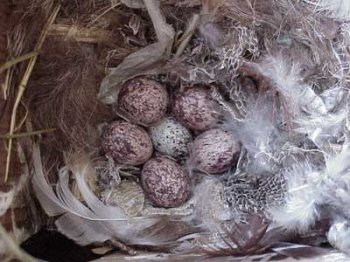
Fledgling. Photo by Richard Hodder.
This male (Alec) was the first to leave the nest. He was also the first to open his eyes, flap his wings and peek out of the entrance hole. He was the largest of the brood.
The difference in size and maturity can be related to the fact that GCFLs start incubating on the penultimate (next to last) egg.
This is the second baby to leave the nest (Alexander). Photo by Richard Hodder.
The family stays together for about three weeks after fledging.
Mother and child. Photo by Richard Hodder.
Audrey picked up the berry (from an unknown tree) from the sidewalk and delicately fed it to her son Alexander before they both flew off.
This picture brings the beauty of life full circle. From meticulously building the nest, to laying eggs, to hatching and feeding, and first flight, Audrey and her son have faced the world together.
This is Betsy Marie's favorite photo.
Adult GCFL. Photo by Richard Hodder. Audrey stayed close by the entire time the babies were fledging. While the camera was clicking, she shrugged her magnificent crest up.
Note from Bet: Some people think they need a huge trail before what they do "counts." Never underestimate the power of a backyard birder! Citizen scientists with even one box can get unusual birds nesting, can observe the nesting process more closely, have better photo opportunities, and get the rare chance to witness fledging.
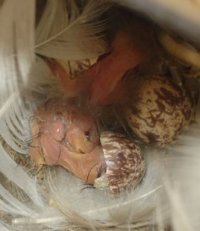
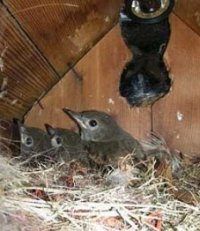
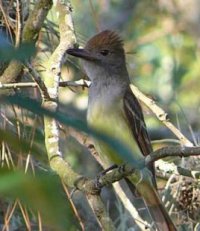
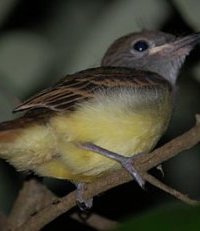
How much will i get in tips at jamba juice? How to hang a mirror? How to sit out in fortnite? What is the meaning of i shot the sheriff? How to tighten loose skin on stomach? sirius black advice to harry in what page what is pitch in music definition what skills are needed to process a minimum of 120 verifications per day How is medicare wages and tips calculated on w2? What does jantelagen meaning? advice for people who want to be consultants what are the benefits of eating kefir what is the difference between excited state and ground state How to make your eye stop twitching? How to pair airpods to laptop? everqueest how to get combat skills when people give you unwanted advice about everything which of the following does not fit in the definition of sexuality in the text? What does copacetic mean? how to apply for ssi benefits what are important skills what do you call a person who gives advice of abortion What does fowl mean? advice when picking out new tv internet phone who did jackson rely on for poltical advice is personality as important as skills when hiring employees How to negotiate salary after a job offer: 6 tips to get more money the cut? how to improve phone signal in house how to get to ip helper what is the definition of specificity what are the basic benefits and purposes of developing pro forma statements and a cash budget? what is the definition of confused what is the difference between mediation and arbitration How to fix anemia? breaking into the game industry: advice for a successful career from those who have done it three houses where to check skills how to launch advice on social nedia how to improve customer shopping experience what is the definition of an xray of the forearm Instagram art tips how to dodraw gold? What does hh mean sexually? what are the benefits of email marketing what is the difference between physical and chemical changes How does carbonaro does his tricks?









